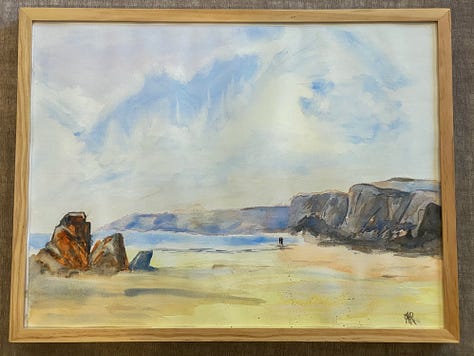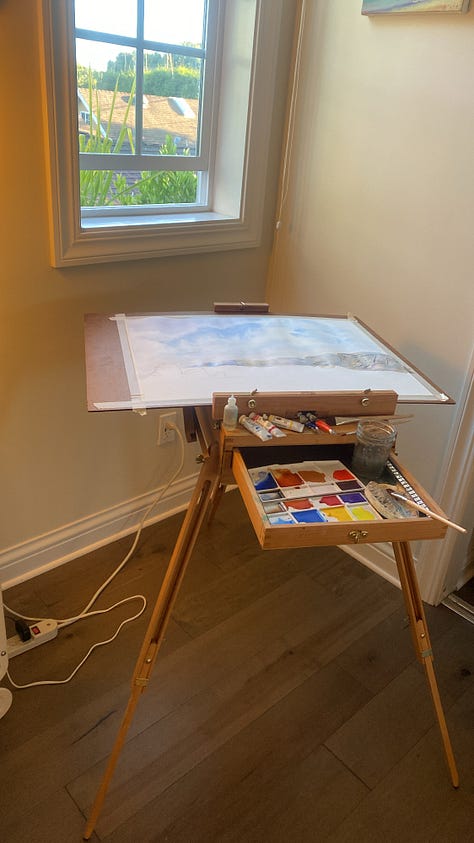Nature as escapism and musings on Impressionism
Join me for a walkthrough my latest watercolor painting's inspiration and techniques



I’ll start with an opening statement on impressionism. A recent trip to the Los Angles Getty Museum inspired me to learn more about impressionism after being struck by Monet’s Notre Dame, Van Gogh’s flowers, and Pissarro’s clouds. I’ve been reading a book on Impressionism that describes it as “subjective perception over objective realism”. Here’s a blurb that further captures the essence of Impressionism:
“The innovation of the Impressionists lay not just in their choice of motifs, for depictions of cathedrals or cafes were nothing new. What they added was a specific execution and goal: ‘The joint intentions of the group... consist not in striving for a polished execution, but in being content with a particular general aspect. Once the impression has been captured, their activity seems to be at an end. If one wished to categorize their intentions in a single word, one would have to create the new term Impressionist. They are Impressionists in the sense that they do not reproduce a landscape, but the impression that it invokes.’’ - Karin H. Grimme, ‘Impressionism’
This captures how I approach painting. Impressionism is several things in one. It’s the use of light and color to convey the artist’s ‘impression’ of the scene.
It was also a rebuttal to the traditional art of the 1800s, French Neo-Classism, which was a realist form of painting often featuring religious or political motifs and a single piece would take years to complete. Instead, the group who became known as the Impressionists (Monet and Van Gough, among others) would paint quickly and in a manner that art critics of the time deemed “unfinished”. The focus was on the cafes and countryside, showing scenes that captured the moment. The world of the Impressionists was undergoing the industrial revolution, and injustices and inequities of the time were front and center. These artists sought freedom in the expression of the world around them through a more impressionistic delivery.
Fast forward to today, in 2023, where modern society is facing another revolution – the age of the Internet accelerating with the arrival of generative AI. We face a startling pace of change as hyper-connectedness becomes the norm, capitalism’s emphasis on units of productivity squeezes the worker, and social media brings the inequities of today to your smartphone.
I imagine having a cup of coffee with an Impressionist artist of the 1800s, we’d have similar experiences to share, through the use of paint as freedom of expression to grapple with and express the changes in the world around us.
Inspiration
Now, onto the painting. Imagine walking along a sandy inlet with rocky cliffs stretching along the coastline. The shimmering, calm ocean hugs the shore, with low tide leaving a wide, sandy beach. You can almost feel the rock in the foreground, slimy and slippery with green algae and dark spots of barnacles from when the tide returns.
There is a couple ahead walking along the shore. They give a sense of adventure and exploration, small figures dwarfed by the ocean and cliffs. There is an intimacy in the pair being dwarfed by the boundless beauty of nature and the sea. Reality suspends itself in a moment of joy and connection. These are the moments we wait for; pearls that string together in moments that show the glorious potential of humanity.
Tool Kit
[tools] - sponge, paper towel, razor, 1” flat brush, 1/4” flat brush, round brush, rigger (super thin brush for small details)
[color palette] - cobalt blue, ultramarine blue, permanent rose, aueroelin yellow, cadmium scarlet, burnt sienna, raw sienna, lemon yellow
Sketch
Before touching the canvas, I sketched out the scene to capture the shapes / focal point and tonal values (more on these below). I also worked on the role of light and color — see if you can tell where the sunlight direction is coming from in this piece (top right / left / center) and which colors form the primary storyline of the piece.
Techniques
wet-on-wet sky | contrasting shape directions | people for scale
The technique to paint clouds starts with the wet-on-wet technique, where you wet the entire sky area with clean water, then quickly layer on the colors. This painting was left wet for longer to create the blurred look, compared to paintings like ‘Reflections in the Sand’ where the paint was dried between layers to create sharper edges to shapes. Next, I did small strokes of a pale mix of aureolin yellow in the middle of the sky, then a pale mix of raw sienna along the bottom of the skyline.
After these, I layered in blue (cobalt blue) into the primary cloud shapes. Note the large zig-zag shaped cloud on the center left and the circular one on the right. The highest cloud was the largest one (perhaps a heavy cumulous cloud?) and I mixed a tinge of permanent rose into the blue to create a slightly more purple cloud. This is where painting is really fun, playing with the light and color to create different effects.
Work in progress photo - Clouds/sky complete, rocky cliffs in progress. More color and texture to be added to the cliffs…
Other techniques include the rocky cliffs acting as a guide for the viewer’s eye toward the focal point in the middle of the page.
The couple are added onto the beach to provide scale for the overall landscape, as well as a touch of storytelling which makes the scene more interesting.
The rocks in the foreground were painted using a ‘stiff’ mix of raw sienna and ultramarine blue, meaning very little water was added so the paint was not diluted very much. This creates the dark colors to contrast with the softer background. A clean, wet brush was dragged across the tops of the rocks to indicate sunlight and highlight shadows. More clean water was worked into the bottom part of the rocks to create the shimmery reflections of the rocks on the wet sand below.
Final Version
‘Nature’s Escapism’
Watercolor landscape
ARR 2023
18”x28”
Would love any thoughts on which part of the piece resonates with you the most or how you’d approach the techniques.
Or if you have guesses on which direction the sunlight comes from or which colors are the primary storytellers.
Also, I’m starting to think of ways to showcase my pieces in person / through some kind of art fair… let me know you have any ideas or pointers for where I should look into this.
Cheers!
Allyson









I really appreciate the detail with which you delineate your process. I’m going the try practicing your sky and rocks. I’ll let you know how it goes.